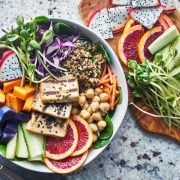Experience Taste in New Ways: Tips For Expanding and Improving Your Palate
If you’ve ever seen a master chef taste food, there’s a good chance you were a little mystified. Can they really taste all of that in a single bite? It’s like they’re pulling a rabbit from a hat. Not even the subtlest flavors elude their palates. Experienced chefs can taste each flavor with an acuteness that allows them to create subtle, delicious combinations.
Most people tend to write this off as natural talent. And some of it certainly is. But, as it turns out, everyone—and that means you—can train their palate to be more sensitive and perceptive. Like most things in life, it just takes a little practice.
Here’s the good news: expanding and improving your palate is a straightforward, rewarding process. And you can start your journey towards a more flavorful life today!
Why Bother? The Benefits of Expanding Your Palate (And Improving it, Too)
To improve your palate, it helps to be adventurous (more on that concept to come). But expanding your palate doesn’t have to be an intensive, laborious process—you can put as much or as little into it as you like. Still, you might have one question upfront: why bother at all? Most people like food, and are perfectly happy sticking to their established culinary routines. They cook and eat the same select foods, taste the same flavors, and, at the end of the day, enjoy themselves.
So if it’s not broken, why fix it, right?
Listen to any chef talk about food for two minutes and you’ll have your answer. They’ve worked to improve and expand their tasting experiences and abilities. And to the trained palate, a meal becomes more than just a meal—there’s a connection to the food that wasn’t there before. That connection can open the door to a world of deliberate, mindful, and, yes, healthy eating.
Sold? Good. Let’s get into some palate development tips.
Improving Your Palate Starts With the Basics: The Five Building Blocks of Flavor
As you expand and train your palate, you are, in a sense, learning a new skill. And as with any new skill, it’s best to start with the basics. (Walk before you run, right?)
Your body can detect five basic tastes: sweet, salty, bitter, sour, and umami. Before exploring the ways these tastes interact to create complex, satisfying flavors, you should be able to identify each on its own. The first four are pretty straightforward, but umami can be tricky to pin down. The term umami comes from the Japanese word for “savory” and is used to describe the savory flavor found in meat, mushrooms, and broth.
Think of your sense of taste like a muscle: the more you try to pick out individual tastes, the better at it you’ll become. So next time you drink a cup of coffee, slow down a bit. Let it sit on your tongue. What do you taste? Obviously, it’s going to taste bitter. But what else can you detect? There might be a slight sourness, too.
Do the same when you eat fruit. The predominant taste may be sweet, but you’ll likely notice other flavors, too. Is it slightly sour? Bitter? As you practice picking these basic flavors out, you’ll start to get a sense for the way they combine and complement one another.
Follow Your Nose—Or At Least Use It
Most people associate taste directly with the tongue. It is, after all, where your taste buds are located. That being said, your taste buds are actually pretty limited in their sensory capabilities—they can detect the five basic tastes, but not much else.
Your nose, on the other hand, can detect somewhere between 10,000 and 1 trillion unique scents. As you eat, your senses of taste and smell combine to create a single experience of “flavor.”
And when it comes to improving your palate, your nose is just as important as your mouth. Before eating (or drinking), give yourself time to sit with the aromas. What elements of the dish can you pick out using just your sense of smell? By identifying these smells, you’re priming the pump so when you do finally eat the food, your attention to smell will help enhance your experience of the food’s flavor.
Step Outside Your Comfort Zone: Improving Your Palate With Exploration
One of the easiest—and most crucial—ways to improve your palate is simply expanding the variety of foods you eat. If you’re a creature of habit at the grocery store and in the kitchen, it might be time to break the cycle.
This doesn’t mean you should go out and buy a pound of lutefisk the first chance you get. Start small. If you typically stick to “safe” greens like iceberg and romaine lettuce, pick up some beet greens, kale, and chard. And just like that, you’ve transformed the flavor profile of tonight’s salad.
Another great way to explore new flavors is by diving into the cooking traditions of countries and cultures that are different from yours. The world is full of diverse, delicious flavors—there’s no reason you need to stick to the ones you are comfortable with. As you dip your toes into various global cuisines, it’s OK to start by eating at restaurants. When you find new dishes and flavors you love, you can then try replicating (and tweaking!) them in your kitchen.
You might be surprised by the familiar ingredients that go into unfamiliar dishes. Something as simple as a potato—which is typically prepared with salt and other basic seasonings in the U.S.—can be transformed into a vessel for myriad herbs and spices in, say, aloo gobi, a popular dish in Indian cuisine. So go out and buy a new cookbook or subscribe to a new food blog—there’s a world of flavors out there waiting!
Remember: you don’t have to like everything. Part of exploration is discovering the flavors and foods you don’t enjoy.
Hit the Reset Button With Palate Cleansers
Flavors linger in the mouth—some more than others. (Think onions, garlic, and other pungent foods.) It’s a fact that’s ruined many a first kiss, and, as it turns out, your ability to detect subtle flavors. Residual tastes in the mouth can mix with new flavors, masking or altering the true flavor of whatever food you happen to be eating next.
Fortunately, there’s a quick solution to this problem: palate cleansers. These neutral-tasting foods help clear residual morsels off of the tongue and “reset” your palate. It’s the reason sushi comes with pickled ginger and why some swanky restaurants bring you sorbet between courses.
But let’s be honest, most people don’t have pickled ginger or sorbet on hand. Don’t worry, because you can use something as simple as a plain cracker, white bread, or a glass of water to cleanse your palate.
Keep Your Mouth Healthy
At this point, everyone is well aware of the health risks associated with cigarettes. But health risks aside, smoking cigarettes can also impact your ability to taste food.
According to one study, the relationship between smoking and reduced taste sensitivity is linear: the more you smoke, the less acute your sense of taste will become. The good news is that the damage to your taste receptors isn’t permanent. Within two months of quitting, most smokers see their sense of taste return to normal.
Smoking, of course, isn’t the only thing that can affect the sensitivity of your taste buds. You should also try to avoid excessively hot, salty, or sugary foods—all of which can dull your sense of taste.
Make Time for Food
Most of these tips and suggestions have built towards a common theme: slow down and really enjoy your food. Savor the moment. If you’re constantly eating on the go, working as you eat lunch, or watching TV during dinner, your attention is split. And good food deserves your full attention.
There’s a name for this practice: mindful eating. You’ve maybe heard of mindfulness in the context of meditation or mental health treatments. But you can also apply the practice to food!
Simply put, mindfulness is the practice of focusing on the present. What thoughts, feelings, and sensations are you experiencing? Acknowledge and accept each one. So what does this look like during a meal?
There are few steps you can take during each meal to make eating a more deliberate, mindful activity:
- Express gratitude: First, take time to consider the labor, ingredients, and expertise that went into growing and preparing your meal. (This applies to home-cooked and restaurant meals.) A lot went into it—be sure to express your appreciation, even if it’s just internally.
- Limit portion sizes: When delicious food is on the table, willpower crumbles. It’s tempting to dive right in and eat as much as you can as fast as you can. But ultimately, this takes away from the experience. Start with smaller portions and chew your food slowly and deliberately. You’ll be shocked at the way the flavors open up when you take your time. When you slow down, your body has more time to register how hungry or full you are, and you’ll likely need to eat less to feel satisfied.
- Don’t come to the table hungry: OK, so this bullet point might be a little misleading. Obviously you should come to the table with an appetite—you want to be able to eat, after all. But you should try to avoid coming into a meal absolutely famished. If you’re ravenously hungry, it’ll be tough to slow down and appreciate the food. Try to find the balance of hungry but not too
What the Destination for Improving Your Palate Looks Like
Picture this: you set out to improve your palate a few months ago and have been gradually enjoying new foods, flavors, and experiences. What’s next? At what point is your palate fully “developed”?
That’s a trick question. Improving and expanding your palate is a never-ending process. As you develop, expand, and improve your palate, you’ll find there’s always more to try. It’s one of the joys of the process, but it can also be a bit imposing. So remember: take this journey on your own terms.
You might not become a master chef, and maybe you’ll always hate Brussels sprouts. At the end of the day, though, all that matters is that you’ve developed a new, exciting relationship to food and flavor.














